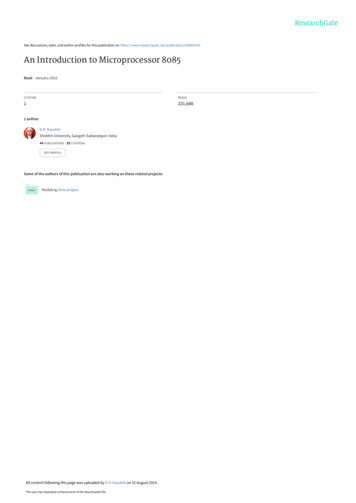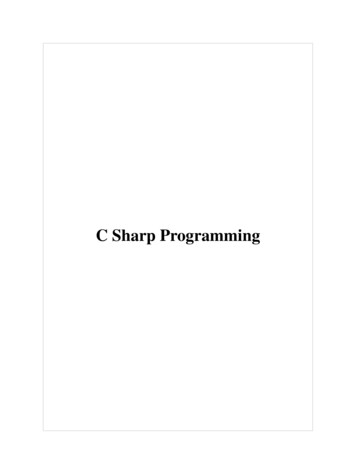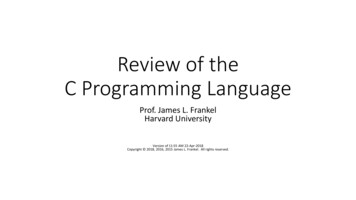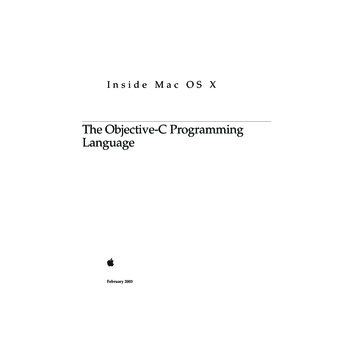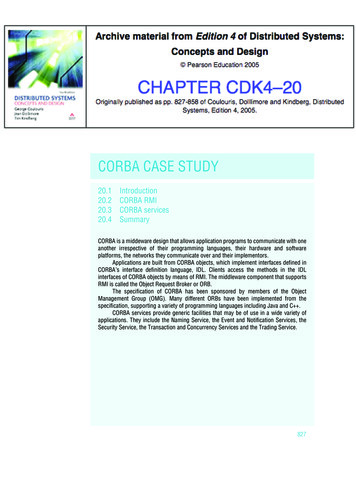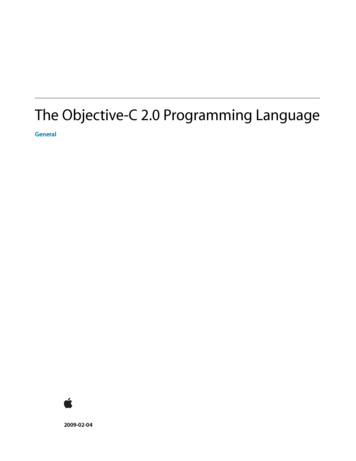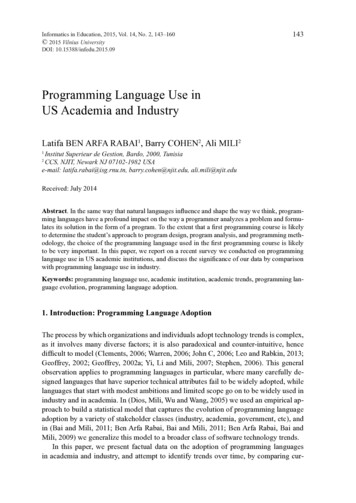
Transcription
Informatics in Education, 2015, Vol. 14, No. 2, 143–160 2015 Vilnius UniversityDOI: 10.15388/infedu.2015.09143Programming Language Use inUS Academia and IndustryLatifa BEN ARFA RABAI1, Barry COHEN2, Ali MILI2Institut Superieur de Gestion, Bardo, 2000, TunisiaCCS, NJIT, Newark NJ 07102-1982 USAe-mail: latifa.rabai@isg.rnu.tn, barry.cohen@njit.edu, ali.mili@njit.edu12Received: July 2014Abstract. In the same way that natural languages influence and shape the way we think, programming languages have a profound impact on the way a programmer analyzes a problem and formulates its solution in the form of a program. To the extent that a first programming course is likelyto determine the student’s approach to program design, program analysis, and programming methodology, the choice of the programming language used in the first programming course is likelyto be very important. In this paper, we report on a recent survey we conducted on programminglanguage use in US academic institutions, and discuss the significance of our data by comparisonwith programming language use in industry.Keywords: programming language use, academic institution, academic trends, programming language evolution, programming language adoption.1. Introduction: Programming Language AdoptionThe process by which organizations and individuals adopt technology trends is complex,as it involves many diverse factors; it is also paradoxical and counter-intuitive, hencedifficult to model (Clements, 2006; Warren, 2006; John C, 2006; Leo and Rabkin, 2013;Geoffrey, 2002; Geoffrey, 2002a; Yi, Li and Mili, 2007; Stephen, 2006). This generalobservation applies to programming languages in particular, where many carefully designed languages that have superior technical attributes fail to be widely adopted, whilelanguages that start with modest ambitions and limited scope go on to be widely used inindustry and in academia. In (Dios, Mili, Wu and Wang, 2005) we used an empirical approach to build a statistical model that captures the evolution of programming languageadoption by a variety of stakeholder classes (industry, academia, government, etc), andin (Bai and Mili, 2011; Ben Arfa Rabai, Bai and Mili, 2011; Ben Arfa Rabai, Bai andMili, 2009) we generalize this model to a broader class of software technology trends.In this paper, we present factual data on the adoption of programming languagesin academia and industry, and attempt to identify trends over time, by comparing cur-
144L. Ben Arfa Rabai et al.rent data against 2010 data; we also analyze possible cross-influences between adoptiontrends in academia and industry; we also analyze possible correlations between languageadoption decisions in academia and institutional rankings. This information may be ofinterest to academic decision makers, as they may want to consider what languages arebeing used across academia, and may be of interest to industry decision makers andrecruiters, as they contemplate what background graduating students have in terms ofknowledge of programming languages and paradigms.2. Programming Language Adoption in IndustryThe Tiobe Software company (http://www.tiobe.com) offers one of the mostcomprehensive, and most timely, surveys of programming language use. This surveyappears to use online resources to assess the use of programming languages in industrialpractice worldwide, and updates its estimates on a monthly basis. For our purposes,we are interested to review the degree of usage of the most common programming languages as of April 2013; in order to analyze evolutionary trends, and to compare withthe data we collected on the use of programming languages in academia, we also recordusage data for April 2010. This data is shown in the Table 1:Table1Tiobe Programming Community Index, C Objective-CC#PHPVisual BasicPythonPerlRubyJavaScriptVB 0.004200.520.130
Programming Language Use in US Academia and Industry145Interestingly, the three top contenders remain the same, and in the same order, namely C, Java then C . The big winner, in terms of positive evolution over the three yearperiod is Objective-C, which jumps forward a full seven ranks, thanks to an increase of7.310 in its adoptive population. The biggest loser in terms of adoptive population isPHP, which loses 4.234 percent of the programmer population; and the biggest loser interms of ranking is Delphi, which drops by six positions (from 9th to 15th). In the nextsection we explore the ranking of languages in academia.Considering alternative sources of information, we have looked at data from the sitehttp://langpop.com/, which dates back to the same period (Fall 2013). Specifically, we have focused on two metrics that this site is interested in, namely: Programming language use. In this metric, the authors attempt to gauge the levelof use of programming languages by combining data from a variety of sources,including google search (a generic search for references to programming languages), github (a search that focuses on open source software), google files (a searchof files with language-specific extensions), craigslist (a search of job postingson craigslist), Ohloh (which measures the number of programmers contributingcode to open source projects). We ran the normalized computation on the basisof github and google search (assigning a weight of 0 to the other three), givinggoogle search a weight of 2 and github a weight of one, because google search ismore generic (whereas github is specific to open source). We give the other threea weight of zero: google files because it is biased (some languages generate morefiles per application than others), ohloh because it is redundant with github (whichis more widely known and used), and craigslist because its data is incidental (itis a broad spectrum site, in which software job posting are only a small fraction,and is not the prime destination of software professionals). With these weights, wefind the following twenty languages at the top: C, Java, C , Objective-C, PHP,JavaScript, Python, Ruby, C#, Visual Basic, Perl, Shell, SQL, Delphi, ASP, Assembler, Scala, Cobol, Pascal, Lua. Out of these twenty languages, a full sixteenare in the Tiobe survey; and the four top languages (i.e. C, Java, C , Objective-C)are in the same order in the two lists. Programming language interest. It has always been our belief, and our observation, that what makes a language popular is not necessarily its intrinsic qualityattributes, but a host of incidental environmental and circumstantial extrinsic factors; so that we feel vindicated that the site http://langpop.com/ finds itnecessary to survey languages according to their level of interest, in addition toa survey based on language usage. To this effect, they collect data from sites thatprogrammers visit to talk about programming languages; they argue that whatlanguages programmers are interested in, and are experimenting with, are notnecessarily the same as what languages programmers are paid to use. The siterefers to three sources, namely: Lambda the Ultimate, which is rather academically oriented, and attracts programming language researchers; programming.reddit.com, which is a combined news site/ social networking site for programmers; and slashdot.org, which has a similar audience to reddit, but is smaller andless influential. We computed normalized results by giving reddit a weight of 2
146L. Ben Arfa Rabai et al.and Lambda a weight of 1 (to lower its impact, since it is academically orientedand we are interested in industrial trends) and Slashdot a weight of 1 (due to itslower impact/ importance). The resulting table provides the following list as thetwenty most interesting programming languages far the Fall 2013: Java, JavaScript, Python, PHP, Perl, C , Ruby, C, SQL, Lisp, Scheme, Haskell, C#, Shell,D, Erlang, Cobol, Assembler, Scala, Objective C. Out of these languages, onlythirteen are part of the Tiobe survey, and many that are in both surveys are atwidely different ranks.Another source of programming language use in industry is RedMonk, which showsa table of language usage in two forums, namely Stack Overflow (an open forum forprofessional programmers) and GitHub (an open source forum). In the right hand corner of the chart, RedMonk shows the languages that are the quarter percentile of bothrankings; these include Java, Java Script, PHP, Python, C , Ruby, C#, C, CSS, Objective C, R, Perl, Shell, Scala, and Haskell. Of these, ten are among Tiobe’s list of twentytop languages.In a recent posting on http://www.mashable.com, Todd Wasserman lists thefollowing languages as important languages that a modern programmer ought to know:Java, Java Script, C#, PHP, C , Python, C, SQL, Ruby, Objective C, Perl, .NET, VisualBasic, R, Swift. These languages are selected and ordered on the basis of their importance for programmers at the high end of the pay scale, according to the online learningplatform Lynda (http://www.lynda.com/). Out of these fifteen languages, no lessthan thirteen show up in Tiobe’s list for April 2013 (whereas the mashable list is dated2015, it must be noted).Overall, it is fair to consider that the Tiobe list is a faithful indicator of the state ofthe practice in language usage in the software industry.3. Programming Language Adoption in AcademiaDuring the spring semester 2013 (January to April 2013) we have conducted a surveyacross US institutions of higher education, collecting data on programming language usefor teaching; specifically, we collected the following data: What programming language is used for the first computing course; some institutions (such as NJIT, for example) have an introductory computing course thatprecedes the first programming course, and is a prerequisite thereof. Such a courseis intended to expose incoming freshmen to general computing concepts, including (but not limited to) programming; hence the programming part of the courseis covered using a user-friendly language that is not necessarily the language oftheir first programming course. What programming language is used for the first programming course? The focusof this course is to teach programming using a programming language as a medium, though it is not uncommon for this course to be geared towards teaching the
147Programming Language Use in US Academia and Industryprogramming language as much as (or more than) it is geared towards teaching aprogramming discipline. What programming language is used for the first data structures course? Of course,this is most typically the same language as that used for the first programmingcourse, but sometimes (more often than we thought) they are different. What languages are covered in the programming language course; this is typicallya junior level course that explores general issues of programming languages, suchas programming language analysis, programming language design, programminglanguage processing, programming language compilers and interpreters, and programming paradigms, and exposes students to some programming languages forpractical assignments.In order to record evolutionary trends, we have collected this data for the springsemester 2013 and the spring semester 2010. We have collected this data for 134 institutions across the US, ranked 1 to 134 in the latest US News and World Report Survey.For the Spring 2013 semester, this data is collected by merely inspecting relevant coursecatalogs, course schedules and (when available) course sites. For the Spring semester2010, it is more difficult to collect this data, as it requires that we find three year oldcourse sites, course catalogs, or course syllabi; occasionally we had to write individualemails to instructors and/or administrators, with limited success; hence we have fewerdata points for 2010 than for 2013.3.1. First Programming CourseTable 2 shows the data pertaining to the programming language used in the first programming course in the spring semester 2013 and the spring semester 2010.Table 2Programming Language Adoption in Academia, 2010–2013First programming tage2010EvolutionPercentageEvolutionRankJavaC 11111–11–1
148L. Ben Arfa Rabai et al.Before we compare these results with the Tiobe data, we need to make the followingobservations: While the data in this table pertains exclusively to academic institutions, the datacollected by Tiobe Software is based on “the number of skilled engineers worldwide, courses, and third party vendors”. Assuming that “courses” refer to industrial courses, in addition, possibly to academic courses, we feel it is fair to considerthat the Tiobe data reflects primarily the industrial trends of the moment. While our data pertains exclusively to US academic institutions, the Tiobe datareflects industrial practice worldwide. We see no compelling reason to believethat industrial practice in the US (in terms of programming language preferences)should be radically different from industrial practice elsewhere, but we need to bemindful of this qualification.With these qualifications in mind, we make the following observations: C, Java and C are in the top four languages in academia and in industry, in 2010and in 2013. But while C is ranked #1 in industry in 2001 and 2013 (perhaps dueto the weight of legacy software), it is ranked 4th in academia in 2013, and 3rd in2010. Academic institutions have more latitude in switching between languagesthan does industry. The distribution of languages in academia is less uniform than the distribution oflanguages in industry: Java is ranked first in academia with a whopping 44.44%,whereas C is ranked first with a mere 17.862%. Another language to watch, besides the three top languages cited above, is Python.With 17.037 % of the market share in academia in 2013, it is nearly as prevalentas the top languages in industry (17.862% for C, and 17.681% for Java). Perhapsmore interestingly, its presence jumps from 5.00% in 2010 to 17.037% in 2013. Inindustry, this language garners 4.442% of the market in 2013, slightly up from itsshowing of 2010 (4.205 %). Among the languages that are used in industry but shunned in academia, it isworth pointing to Object-C, whose market share is a significant 9.598 %, and toC#, whose market share in industry is 6.150 %. Some of the languages that appear in academia but not industry include MatLab,Haskell, Scheme and Racket. The rationale for using a language that is not used inindustry is that we want a language that best supports a programming discipline,and that once students acquire a sound discipline, migrating to another languageis a simple matter (Yi, Li and Mili, 2007).In order to get a clearer sense of which languages are gaining ground in academia(in a first programming course), and which languages are losing ground, we have considered the four top languages of the table above and recorded how universities have(or have not) changed their adopted language from 2010 to 2013. The results are summarized in the matrix below, where rows represent the languages adopted in 2010 andcolumns represent the languages adopted in 2013. The diagonal represents the numberof institutions that have maintained their choice of language, and outside the diagonalwe represent the number of institutions that have moved from the language represented
Programming Language Use in US Academia and Industry20132010C JavaC 9in row to the language represented in column. From this table, it is clear that Python isshowing the greatest positive evolution (loss of 1, gain of 5), even though it currentlyhas the lowest adoption rate.An interesting question that we want to explore is whether the choice of languagesfor the first programming course is correlated with institutional rank; to this effect, wedivide our sample of 134 institutions into four quartiles according to their ranking in thelatest US News and World Report survey (1 to 33, 34 to 66, 67 to 99, and finally 100 to134). For completeness, we have also added a column for language adoption in MOOCs(Massive Open Online Course), including sites such as Coursera, edX, Udacity, Udemy,Codecademy, Lynda.com and Treehouse. The results, which we limit to the nine toplanguages of Tiobe’s survey for April 2013, are summarized in the Table 3:The only trend that appears to be monotonic is the percentage of adoption of C ,which increases from 14.286 % for first tier institutions to 34.286 % for fourth tier institutions. From the first tier to the third tier, the adoption of Java drops precipitously, andis compensated almost perfectly by the adoption of Python. Except for the fact that itincludes many languages (such as Ruby, JavaScript, CSS, HTML, HTML5) that are notpart of the sample, the set of languages adopted by MOOCs looks closer to the column oftop tier universities (ranks 1 to 33); many of the MOOCs are operated by top-tier institutions, which justifies this observation.Table 3Programming Language Adoption vs. Institutional Ranking First Programming Course, 2013LanguageInstitutional Ranking1 to 3334 to 6667 to 99100 to .867.7715.55C Visual 10.00Perl0.000.000.000.000.00
150L. Ben Arfa Rabai et al.3.2. First Data Structures CourseWhereas, for the sake of convenience, it is natural to use the same programming languagein the first programming course and the first data structures course, there is also somerationale for using different languages. Indeed, one may argue that these two courses dealwith distinct/orthogonal programming disciplines (top down versus bottom up) and distinct design approaches (functional decomposition versus data modeling). Hence we wereonly moderately surprised, though surprised nevertheless, when we found that a full 32 %of institutions in our sample used different languages in the first programming course andthe first data structures course. Table 4 shows, side by side, the percentage of languagesused for the first programming course and the first data structures course in our sample.The difference between the distribution of languages in the first programming courseand the distribution of languages in the first data structures course is sufficiently large toindicate that in fact, institutions do not automatically adopt the same language for thesetwo courses. The following table (Table 5) further elucidates this observation by showing how institutions are distributed in terms of language adoption for the first programming course (in rows) and for the first data structures course (in columns) – where werestrict our attention to the main languages cited in section 3.1.3.3. First Computing CourseMost universities we have surveyed offer a first computing course distinct from thefirst programming course, though it includes a significant programming component. Bycontrast with the first programming course, which focuses specifically on teaching aprogramming discipline, the first computing course introduces students to a wide rangeof computing topics, and is usually used as a prerequisite to subsequent CS courses, and/Table 4First Programming Course, versus First Data Structures Course, 2013Language1st Programming CourseRankPercentage1st Data Structures CourseRankPercentageJavaC .000.000.000.000.930.000.00
151Programming Language Use in US Academia and IndustryTable 5Transitions from First Programming Course to First Data Structures CourseData StructuresCJavaC Python3322111642578152191111111ProgrammingCJavaC PythonJava PHP1or as an introductory computing course for non CS majors. Programming languages forthe first computing course have to meet a different set of requirements from those ofprogramming courses; they are typically chosen for their user-friendliness, their ease oflearning and their ease of use, rather their relevance in industry. Hence it is not surprisingthat very few universities (only 2 out of our sample of 134) use the same programminglanguage for the first computing course and the first programming course. Our data issummarized in Table 6:Two observations are striking: First, the choice of programming language for the firstcomputing course appears to be taken without consideration for what is in vogue in industry; second, this decision appears to be in flux, in light of the broad swings that we findin adoption figures between the 2010 data and the 2013 data. It bears pointing out thatwe have far less data for 2010 than we have for 2013, due to the difficulty of collectingarchival data. Table 7 shows the adoption pattern as a function of institutional ranking.3.4. Programming Languages CourseWhereas languages for the first computing course are chosen for their ease of use, whereas languages for the first programming course are chosen with an eye on the market, andwhereas languages for the first data structures course are chosen to support data structurerepresentation and manipulation, languages for the programming languages course arechosen for their educational value (if they embody a meaningful/ unique programmingparadigm), their design attributes (if they capture meaningful design principles), or theirhistorical significance (if they have influenced subsequent languages, or spawned manyvariations). Consequently, the list of languages chosen for the programming languagecourse cover a broader range than the earlier lists, and include older languages, and lessmainstream languages; also, because of the criteria used to select these languages, theytend to evolve more slowly from year to year, as they are not subject to market pressures.Our data is summarized in Table 8:
152L. Ben Arfa Rabai et al.Table 6Programming Language Adoption in Academia, 2010–2013First Computing onVisual hemeMathematicaCSwayMapleSecond LifeC 8–17–1–122–62–62–62–7–9–62Table 7Programming Language Adoption vs. Institutional RankingFirst Computing Course, 2013LanguageMATLABPythonVisual BasicInstitutional Ranking1 to 3334 to 6667 to 99100 to .0013.33HTML0.000.000.0013.33Among the top fifteen languages, we find Prolog ranked very high, in second position, even though it is nowhere to be seen in the Tiobe survey, nor in the list of programming languages used in other courses; this language is used as a vehicle for discussinglogic programming. Another impressive showing is the collective figure of functional
153Programming Language Use in US Academia and IndustryTable 8Programming Language Adoption in Academia, 2010–2013Programming Language C ��4–4–14–18programming languages, which include Scheme (ranked 4th), Haskell (ranked 6th), ML(ranked 7th), Lisp (ranked 8th), OCAML (ranked 10th), SML (ranked 13th), and CAML(ranked 21); together, they account for a total of 32.772 %, and support the practiceof functional programming. The interest of Ada (ranked 10th) is that it was developedthrough a worldwide competition, and that it embodies the state of the art in languagedesign for its era (late seventies/ early eighties); it has many advanced features, thatare not found in any of the languages that are currently in use. Smalltalk (ranked 15th),Simula (ranked 21st) and Modula (also ranked 21st) are languages that support modularprogramming by providing object oriented functionalities. As far as evolution between
154L. Ben Arfa Rabai et al.2010 and 2013, the empirical data bears out our expectation that the distribution of themain languages remains relatively unchanged: the top eight languages have maintainedthe same rankings between 2010 and 2013, within a limit of 1.Table 9 shows the distribution of the top twelve languages (those with a percentageof use greater than 3.00) divided according to institutional ranking.Third tier institutions (ranked 67 to 99) use Java and C the least, and use Prolog,Scheme, Haskell and Lisp the most. First tier institutions use OCAML the most, andtheir use decreases with institutional ranking. The use of C increases monotonicallyfrom first tier to fourth tier.4. Cross InfluencesIn (Ben Arfa Rabai, Bai and Mili, 2011) we had speculated on whether and to what extent language choices in academia and industry influence each other: Industries may takethe lead in adopting a language, forcing universities to follow in a bid to better preparetheir students for the job market; conversely, universities may take the lead in adoptinga language, producing generations of students who are proficient in this language, whoin time may propagate the language in industry. To test whether our data bears out onehypothesis or the other, we compute statistical correlations between language adoptionin 2013 by one stakeholder (academia or industry) and language adoption in 2010 bythe other stakeholder; we do so for the most common languages in our sample, namelythose that have a significant following in both academia and industry in 2013 and 2010.For academic courses, we consider the first programming course, because it is the coursethat is most likely to be influenced by industry trends, and is most likely to influenceindustry trends.Table 9Programming Language Adoption vs. Institutional RankingProgramming Language Course, 2013LanguageJavaPrologC nal Ranking1 to 3334 to 6667 to 99100 to 76.254.174.17
155Programming Language Use in US Academia and IndustryTable 10 shows the adoption figures for relevant languages in 2010 and 2013, for academia and industry; and Table 11 shows statistical correlations between these columns.The correlations between academia 2010 and industry 2013, as well as the correlationbetween industry 2010 and academia 2013 appear to be both moderate, and virtuallyidentical; this precludes any claim of a significant influence one way or the other (whichdoes not mean there is no influence, only that our data does not reveal any). What is alsopossible is that while one stakeholder influences the other, it takes more than 3 years forthe effect to show.5. ConclusionThis paper presents some factual data about the adoption of programming languages inacademia and industry, for years 2013 and 2010. Among the most striking results thatcame out of our survey, we cite the following: C, C and Java occupy top places in the ranking of language use in industry, andin the ranking of language use in the first programming course in academia. Virtually all of the languages that were developed in academia with the expressgoal of supporting education are uniformly shunned by academic institutions, andrarely used outside their home institution.Table 10Cross Influences, Academia and Industry 2010–2013LanguagesJavaCC C#PythonJava 718.0518.069.714.434.202.479.662.22Table 11Correlation between Adoption Figures 2010–2013Academia2013Academia 20131Academia 2010Industry 2013Industry 10,9661
156L. Ben Arfa Rabai et al. There is no measurable cross-influence of industry and academia in terms of programming language adoption, i.e. none appears to directly influence the adoptiondecision of the other, at least not within the three-year lead time that we haveconsidered for our data col
odology, the choice of the programming language used in the first programming course is likely to be very important. In this paper, we report on a recent survey we conducted on programming language use in US academic institutions, and discuss the significance of our data by comparison wi




